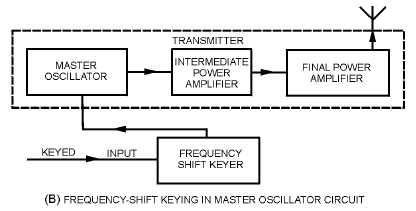2-8
Figure 2-4B.—Two methods of frequency-shift keying (fsk). FREQUENCY-SHIFT KEYING IN MASTER
OSCILLATOR CIRCUIT.
ADVANTAGES OF FSK OVER AM.—Frequency-shift keying is used in all single-channel,
radiotelegraph systems that use automatic printing systems. The advantage of fsk over on-off keyed cw is
that it rejects unwanted signals (noise) that are weaker than the desired signal. This is true of all fm
systems. Also, since a signal is always present in the fsk receiver, automatic volume control methods may
be used to minimize the effects of signal fading caused by ionospheric variations. The amount of inherent
signal-to-noise ratio improvement of fsk over AM is approximately 3 to 4 dB. This improvement is
because the signal energy of fsk is always present while signal energy is present for only one-half the time
in AM systems. Noise is continuously present in both fsk and AM, but is eliminated in fsk reception.
Under the rapid fading and high-noise conditions that commonly exist in the high frequency (hf) region,
fsk shows a marked advantage over AM. Overall improvement is sometimes expressed as the RATIO OF
TRANSMITTED POWERS required to give equivalent transmission results over the two systems. Such a
ratio varies widely, depending on the prevailing conditions. With little fading, the ratio may be entirely
the result of the improvement in signal-to-noise ratio and may be under 5 dB. However, under severe
fading conditions, large amounts of power often fail to give good results for AM transmission. At the
same time, fsk may be satisfactory at nominal power. The power ratio (fsk versus AM) would become
infinite in such a case.
Another application of fsk is at low and very low frequencies (below 300 kilohertz). At these
frequencies, keying speeds are limited by the "flywheel" effect of the extremely large capacitance and
inductance of the antenna circuits. These circuits tend to oscillate at their resonant frequencies.
Frequency-shifting the transmitter and changing the antenna resonance by the same keying impulses will
result in much greater keying speeds. As a result, the use of these expensive channels is much more
efficient.
Q-1.
What are the two types of angle modulation?
Q-2.
Name the modulation system in which the frequency alternates between two discrete values in
response to the opening and closing of a key?
Q-3.
What is the primary advantage of an fsk transmission system?
Frequency Modulation
In frequency modulation, the instantaneous frequency of the radio-frequency wave is varied in
accordance with the modulating signal, as shown in view (A) of figure 2-5. As mentioned earlier, the
amplitude is kept constant. This results in oscillations similar to those illustrated in view (B). The number

